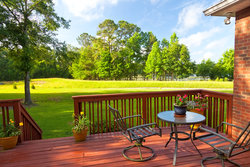 It’s that time of year again. Deck build overload. The time when it seems like requests for new decks or deck re-builds are coming out of the woodwork (pun intended). And while the extra work is always welcome, it can become overwhelming trying to keep up. The key to staying above water by finishing as many builds as possible is to create beautiful decks that the customer is looking for faster. Faster in some cases is not always better, but it is when it refers to new deck builds that are constructed using the highest quality materials. To help you do just that, here are 10 do’s and don’ts for a successful deck build that will have your customers recommending you all over town.
It’s that time of year again. Deck build overload. The time when it seems like requests for new decks or deck re-builds are coming out of the woodwork (pun intended). And while the extra work is always welcome, it can become overwhelming trying to keep up. The key to staying above water by finishing as many builds as possible is to create beautiful decks that the customer is looking for faster. Faster in some cases is not always better, but it is when it refers to new deck builds that are constructed using the highest quality materials. To help you do just that, here are 10 do’s and don’ts for a successful deck build that will have your customers recommending you all over town.
1) Do talk to your customer:
Spend the extra time necessary to talk with the homeowner to get an accurate description of what type of deck they are interested in having built. Be sure to lay out specific plans and get their final approval before you begin. Any miscommunication can have you re-doing what you have started which will put you behind schedule and only frustrate your client. Also be very clear about how long you expect the job to take. Excited customers can turn into anxious customers if they “thought” the work would be done before it actually is. Good communication up front and during the build, can help avoid a myriad of problems.
2) Do Your Homework:
Apply for necessary building permits as soon as it’s possible to do so. Nothing is more frustrating than having to wait on a permit to get started. It upsets the customer and even more frustrating, you wind up with a crew that’s got nothing to do but sit and wait.
3) Do Educate your client:
As you know, there are several different materials that you can use to build a deck. Redwood, Cedar and pressure treated pine are the traditional woods used to build decks and are still widely used today. The cost will vary based upon current lumber supply. Composite decking is becoming increasingly popular. The cost is significantly higher than wood, but this material is very durable and requires little maintenance. It is important to consider how much traffic the deck will see and where is it positioned in terms of the sun. Factors like this will help you and your client determine the best materials to use.
4) Don’t forget to use a building calculator to help you estimate materials:
Once you’ve got your permit and have started building, don’t make the common mistake many contractors make by underestimating materials. It’s maddening to have to stop a job because you have run out of something you need. Use a good quality deck calculator to help you determine how much lumber, fasteners and railings will be needed to complete the job.
5) Do consider the weather when digging footers:
It’s a common mistake made by many contractors and it can be a costly one too, but it’s really an important topic to consider if you are building in an area with temperature fluctuations. As the season changes, the ground freezes and thaws, so be sure to dig and pour your deck footings below the frost line. This will keep them stable year round and your deck will be safer and more secure.
6) Don’t use any boards with warping, mildew or excessive insect holes:
They are subject to rotting and splitting. It’s so frustrating to have to return or exchange wood with imperfections and it slows down production, but it’s even more frustrating to get callbacks.
7) Don’t skimp on the deck fasteners:
Using the wrong fasteners can make all the difference to the longevity of the deck and your reputation as a builder. We recommend the InvisiDeck® Hidden SCRAIL® Fastening System. The InvisiDeck Hidden Fastening System works with grooved and non-grooved boards applications and dramatically reduces time and cost while creating smooth decking surfaces free from any visible fastener heads

8) Do take time to plan the location and construction of the stairs:
Remember that you don’t have to stick with just one set of stairs either. If the deck is large, a set of stairs on each side will help with access and will elevate your project to a entirely different level. It’s more labor, but will fetch a higher dollar.
9) Don’t forget to check building codes for railings when building a second story or multi-level deck:
If it’s a low grade deck, a partial railing might do the trick as well.
10) Do encourage your customer to enhance their new deck with accents like built-in benches, accent lighting and plant holders:
While they may not like the additional cost up front, they will be happier when it’s done and more apt to recommend you for your expertise.
For more information on deck builds, download our Whitepaper: 
.svg.png)
